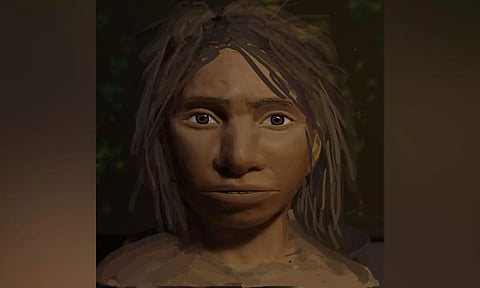

• CARL ZIMMER
CENTRAL AFRICA: Neanderthals may have vanished 40,000 years ago, but they are no strangers to us today. Their stocky skeletons dazzle in museums around the world. Their imagined personas star in television ads. When Kevin Bacon noted on Instagram that his morning habits are like those of a Neanderthal, he did not stop to explain that our ancient cousins interbred with modern humans expanding out of Africa.
But there’s no such familiarity with the Denisovans, a group of humans that split from the Neanderthal line and survived for hundreds of thousands of years before going extinct. That’s largely because we have so few of their bones. In a new review paper, anthropologists tally all of the fossils that have been clearly identified as Denisovan since the first discovery in 2010. The entire list consists of half a broken jaw, a finger bone, a skull fragment, three loose teeth and four other chips of bone.
“The bits of Denisovan we have, it’s almost nothing,” said Janet Kelso, a paleoanthropologist at the Max Planck Institute for Evolutionary Anthropology in Leipzig, Germany, who helped write the review. Nevertheless, many scientists are growing increasingly fascinated by Denisovans. Like us, they were extraordinarily resilient, arguably more so than Neanderthals. “I find Denisovans way more interesting,” said Emilia Huerta-Sanchez, a geneticist at Brown University.
What the Denisovans lack in fossils they make up for in DNA. Geneticists have been able to extract bits of genetic material from teeth and bones dating back 200,000 years. They have found genetic clues in the dirt of cave floors. And billions of people on Earth carry Denisovan DNA, inherited from interbreeding.
The evidence offers a picture of remarkable humans who were able to thrive across thousands of miles and in diverse environments, from chilly Siberia to high-altitude Tibet to woodlands in Laos — perhaps even in the Pacific islands. Their versatility rivals our own.
“What we have found out about Denisovans is that, from a behavioral perspective, they were much more like modern humans,” said Laura Shackelford, a paleoanthropologist at the University of Illinois.
The Denisovans get their name from the Denisova Cave in Siberia, where their remains were first identified. Russian paleontologists had been pulling up bits of bone from the cave floor for years when Dr. Kelso and other researchers offered to search them for DNA.
A molar tooth somewhere between 122,700 and 194,400 years old contained Neanderthal-like genes. But the tooth’s DNA was distinct enough to suggest it had come from a separate branch of human evolution. A finger bone dating back 51,600 to 76,200 years belonged to the same lineage, demonstrating that it had existed for tens of thousands of years — if not more.
Since then, researchers have found more Denisovan fossils in the cave, and they have also gathered loose genetic material from the cave floor. The samples date from 200,000 to 50,000 years ago. A 90,000-year-old bone fragment belonged to a Denisovan-Neanderthal hybrid, showing that the two groups sometimes interbred.
Dr. Kelso and her colleagues quickly came to suspect that the Denisovans had not been limited to Siberia.